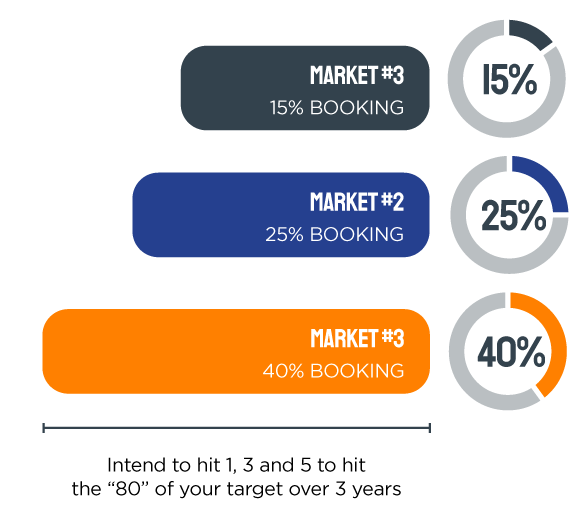The following is a guest article by Eric Meerschaert, Executive Director of Strategy at Studio North.
Taking share in your top verticals with a limited budget requires an aggressively sharpened focus. Many marketers achieve that focus with a market takedown approach—a bottom-up strategy that focuses your sales and marketing on narrowly defined market targets you can own and win.
And market takedowns start with beachheads.
Beachheads are an aggressive attack plan on a market (analogous to Normandy for WWII) from which you weaken the enemy and launch campaigns to win the broader war (a bigger marketplace).

By the late 90’s, those who adopted his principles and stayed focused on them outperformed their markets significantly. Documentum built much of their revenue in one market – pharmaceuticals. They had several beachhead markets they picked to achieve that position. Oracle started with high-growth late-stage drug trials to win back the pharmaceutical market, ultimately owning 10 of the top 10 in that market.
Getting the beachheads right is the key to success. So, in this article, we share 3 ideas to help you pick the right beachheads and start on the right track to success:
- Use market math to guide your selection and your expectations,
- Be clear about risks and strategies to address them,
- Patience is critical to driving success. Start with realistic expectations and make sure your team has the metrics and disciplined management to tune and achieve results.
Use Market Math to Guide Selection of Beachheads
First, define a set of options that are small starting points on a larger market. For example, a larger market might be North America microcircuit contract manufacturing. That’s still too big for a beachhead. So, you begin to define narrowing options:
- Mid-market custom high tech, less than $1 B in annual sales
- Transportation market componentry
- AV equipment $250M to $5 Billion

Now, pick your beachhead. Select a narrower focus for your beachhead until you can realistically achieve a noticeable market share. If you’re just starting, 5%. If you’re already in the market and have a 5% share, then target 10%. Target this share over a 3-year time period.
Now, complete the math. Market math uses information like average deal size, experiences with your solution on lead response rates, conversion rates across the pipeline and average expected deal sizes to model arrival rates of leads and cost per lead. Let this dictate the returns on investment.
In the example below, our sample company wants to grow a market to 60 million. A targeted market should deliver $15 million of that objective. We’ve selected large enterprises for our beachhead. After analyzing our beachhead market, we determine that the average new product sale for large customers is $500,000, so we must book 18 deals. Can we?
In the table above, we work backward from closed deals. Each ratio backward in the funnel should either be our current ratio, or we select some waypoint along the way to approaching better practices. These ratios are only examples.
The math says we need 102 MQL’s. Is the market big enough to get there? Geoffrey Moore gives us another hint. Innovative and Early Adopter markets mean that 2% to 7% of those who could buy will buy a solution. Mainstream markets can have as much as 25% of the market buying. So, you must be in a market, when considering the number of players, you can find approximately 1,500 buyers. Some will go to existing relationships. Some will go to other buyers. Did you pick a beachhead that is achievable?
Last, validate that the investment you need to make is reasonable. Each market behaves differently. For example, in the software market, model your marketing budget in the beachhead at 12%, while modeling other “standard” markets slightly less than your current level. Creativity will be required to shift marketing budgets to fund the beachhead.
We find that using this math approach is an iterative process that helps you refine your targeted markets, declare right-sized beachheads, and have a business case with the details that win over CFO’s and CEO’s. You are more likely to get your funds when you know why and when they will work.
Be Clear About Risks and Strategies to Address them.
Any marketplace you attack has risks. To be successful, you must use the following tools to address the critical risks of succeeding at your beachheads:
- Right Size – A beachhead has to be small enough to gain a noticeable share, like 5% to 10%. If you can, pick a beachhead that supports a substantial and noticeable share. Math will tell you if you’ve picked the right aspiration.
- Clear Advantage – You should have some very real differential advantages, ones that matter to buyers and their personal careers. Don’t pick a market or a beachhead in which you have no significant differences from competitors who stand in your way.
- Barrier Free – Every market has challenges. The point here is to avoid significant barriers, like: big product gaps, big skill gaps, or several larger competitors who already own the market.
- Linkage – Your beachhead should be inside your targeted marketplace. This means you’re tapping into the same or a closely related market. Why? So that you may quickly expand into the larger market without wholesale changes in messaging. For example, Oracle picked late-stage, pre-market pharmaceutical companies to ultimately spring forward into owning the pharmaceutical marketplace with significant share from SAP and other ERP solution providers.
- Adjacency – If you follow Geoffrey Moore’s Crossing the Chasm your first beachhead should be close to your next beachhead and within the same market. While I do not know if Oracle did this, an example could be that Oracle starts with late-stage drug trials, knocks that down, as part of winning the pharmaceutical market. The adjacent beachhead might be regulated devices. It is very near to pharmaceuticals and part of the regulated market. Skills transfer. Some messaging transfers. Credentials and references matter. You get the point.
Have Appropriate Patience
Last, let’s set the right expectations for timing of investments and arrival rate of leads. Programs take time to create. They should use techniques focused purely on generating awareness. We find that awareness is critical to driving leads.
Your first outbound campaign (whether ABM, broader email, or PPC/social) will likely not generate mountains of leads in the first four to six weeks. Don’t cancel your campaign; instead, manage your results with discipline and frequent inspection, tuning every dimension. Pay attention to calls of action. Line up your story and creative so each touch is part of a very clear journey. And nurture every response, because you fight hard to gain each response and each lead.
Beachheads give us powerful ways to start the journey to taking down markets. Be courageous, stay focused, and commit the funds to win your beachhead.
Want more background on market takedowns? Download this guide to deploying market takedowns in your targeted verticals.
About the Author: Eric Eric Meerschaert is the Executive Director of Strategy at StudioNorth. Eric has a deep background in marketing leadership at Global 500 software companies, and was president of Click Commerce. His strategy roots grow from McKinsey & Co, where he learned that analytics, not instincts, drive the best corporate and market strategies.









Add Comment